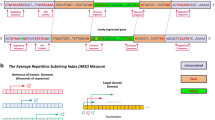Abstract
The systematic sequencing of the yeast genome reveals the presence of many potential genes of unknown function. One way to approach their function is to define which regulatory system controls their transcription. This can also be accomplished by the detection of an upstream activation sequence (UAS). Such a detection can be done by computer, provided that the definition of a UAS includes sufficient and precise rules. We have established such rules for the UASs of the GAL4, RAP1 (RPG box), GCN4, and the HAP2/HAP3/HAP4 regulatory proteins, as well as for a motif (PAC) frequently found upstream of the genes of the RNA polymerase A and C subunits. These rules were applied to the chromosome III DNA sequence, and gave precise predictions.
Similar content being viewed by others
References
Bork P, Ouzounis C, Sander C, Scharf M, Schneider R, Sonnhammer E (1992) Protein Sci 1:1677–1690
Bowman SB, Zaman Z, Collinson P, Brown AJP, Dawes IW (1992) Mol Gen Genet 231:296–303
Bram RJ, Lue NF, Kornberg RD (1986) EMBO J 5:603–608
Bucher P (1990) J Mol Biol 212:563–578
Buchman AR, Lue NF, Kornberg RD (1988) Mol Cell Biol 8:5086–5099
Capieaux E, Vignais M-L, Sentenac A, Goffeau A (1989) J Biol Chem 264:7437–7446
Danchim A, Médigue C, Gascuel O, Soldano H, Hénaut A (1991) Res Microbiol 142:913–916
Dequard-Chablat M, Riva M, Carles C, Sentenac A (1991) J Biol Chem 266:15300–15307
Dessen P, Fondrat C, Valencien C, Mugnier C (1990) CABIOS 6:355–356
Falco SC, Dumas KS, Livak KJ (1985) Nucleic Acids Res 13:4011–4027
Fondrat C, Dessen P, Le Beux P (1986) Nucleic Acids Res 14:197–204
Forsburg SL, Guarente L (1988) Mol Cell Biol 8:647–654
Giniger E, Varnum SM, Ptashne M (1985) Cell 40:767–774
Hill DE, Hope IA, Macke JP, Struhl K (1986) Science 234:451–457
Hope IA, Struhl K (1985) Cell 43:177–188
IUPAC-IUB Nomenclature commitee (1985) Eur J Biochem 150:1–5
Lambertus PW, Mager WH, Nieuwint RTM, Wassenaar GM, Van der Kuyl AC, Murre JJ, Hoekman MFM, Brockhoff PGM, Planta RJ (1987) Nucleic Acids Res 15:6037–6048
Leer RJ, Van Raamsdonk-Duin MMC, Mager WH, Planta RJ (1985) Curr Genet 9:273–277
Marmorstein R, Carey M, Ptashme M, Harrison SC (1992) Nature 356:408–414
Nakai K, Kanehisa M (1992) Genomics 14:897–911
Oechsner U, Hermann H, Zollner A, Haid A, Bandlow W (1991) Mol Gen Genet 231:447–459
Olesen J, Hahn S, Guarente L (1987) Cell 51:953–961
Oliver S, et al. (1992) Nature 357:38–46
Pearson WR, Lipman DJ (1988) Proc Natl Acad Sci USA 85:2444–2448
Planta RJ, Raué HA (1988) Trends Genet 4:64–68
Repetto B, Tzagoloff A (1989) Mol Cell Biol 9:2695–2705
Repetto B, Tzagoloff A (1990) Mol Cell Biol 10:4221–4232
Rotenberg MO, Woolford JL (1986) Mol Cell Biol 6:674–687
Shore D, Nasmyth K (1987) Cell 51:721–723
Stormo GD (1990) Methods Enzymol 13:211–219
Tanaka S, Isono K (1993) Nucleic Acids Res 21:1149–1153
Trawick JD, Rogness C, Poyton RO (1989) Mol Cell Biol 9:5350–5358
Vignais M-L, Huet J, Buhler J-M, Sentenac A (1990) J Biol Chem 265:14669–15674
Werner M, Feller A, Pierard A (1985) Eur J Biochem 146:371–381
Yoshikawa A, Isono K (1990) Yeast 6:383–401
Author information
Authors and Affiliations
Additional information
Communicated by A. Goffeau
Rights and permissions
About this article
Cite this article
Fondrat, C., Kalogeropoulos, A. Approaching the function of new genes by detection of their potential upstream activation sequences in Saccharomyces cerevisiae: application to chromosome III. Curr Genet 25, 396–406 (1994). https://doi.org/10.1007/BF00351777
Received:
Accepted:
Issue Date:
DOI: https://doi.org/10.1007/BF00351777




